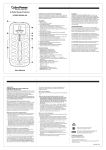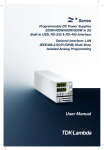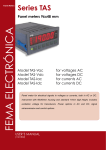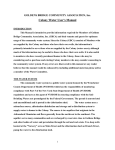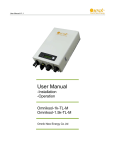Download User`s Manual - Cyber Power Systems
Transcript
User’s Manual CPSPV5000ETL CPSPV4000ETL CyberPower Systems Inc. www.cpsww.com IMPORTANT SAFETY INSTRUCTIONS Save These Instructions! This manual contains important constructions that shall be followed during the installation and maintenance of the CyberPower Grid Tie Solar Inverter. CAUTION! Before installation and using the Inverter, read all instructions and cautionary markings on the inverter and appropriate sections of this guide. About This Manual This purpose of this Installation & Operation Manual is to provide explanations and procedures for installing, operating, maintaining, and troubleshooting the CyperPower Grid Tie Solar Inverter. CAUTION! To reduce risk of fire hazard, do not cover or obstruct the heat sink. Scope CAUTION! Observe the clearance recommendations. Do not install the Inverter in a zero-clearance or non-ventilated compartment. Overheating may result. This manual provides safety guidelines, detailed planning and setup information. It provides procedures for installing the inverter and information about operating and troubleshooting the unit. It dose not provide details about particular brands of photovoltaic (PV) panels. You need to consult individual PV manufacturers for this information. CAUTION! Use only accessories recommended or sold by the manufacturer. Doing otherwise may result in a risk of fire, electric shock, or injury to persons. Audience CAUTION! To avoid a risk of fire and electric shock, make sure that existing wiring is in good condition and that wire is not undersized. Do not operate the Inverter with damaged or substandard wiring. This manual is intended for anyone who needs to install and operate the inverter. Installers should be fully educated on the hazards of installing electrical equipment. Certified electricians or technicians are recommended. CAUTION! Do not operate the Inverter if it has received a sharp blow, been dropped, or otherwise damaged in any way. CAUTION! Do not disassemble the Inverter. It contains no user-serviceable parts. Attempting to service the Inverter yourself may result in a risk of electrical shock or fire and will void the factory warranty. Abbreviation and Acronyms CAUTION! To reduce the risk of electrical shock, disconnect both AC and DC power from the Inverter before attempting any, maintenance or cleaning or working on any circuits connected to the inverter. Turning off controls will not reduce this risk. Internal capacitors remain charger for 5 minutes after disconnecting all source of power. AC: Alternating Current DC: Direct Current CAUTION! The Inverter must be connected to an equipment-grounding conductor directly or via the AC ground. LCD: Liquid Crystal Display ATTENTIO: Risk of burning: During operation the case temperature may exceed 140 (60 ) , do not touch. LED: Light Emitting Diode HIGH VOLTAGE: Before opening the device, disconnect from the grid and the PV generator. The device may only be opened by an electrician. MPPT: Maximum Power Point Tracking PC: Personal Computer PV: Photovoltaic PWM: Pulse Width Modulation ! CAUTION! Cautions identify conditions or practices that could result in damage to the unit or other equipment. Vac: Volts AC IMPORTANT: These notes describe things which are important for you to know, but not as serious as a caution or warning. Vdc: Volts DC VMP: Voltage at Maximum power VOC: Open Circuit Voltage ℉ ℃ The following conventions are used in this guide. ! WARNING! Warnings identify conditions that could result in personal injury or loss of life. 1 Copyright © 2012 CyberPower Systems, Inc. UNPACKING 2) Stainless wall mount bracket 3) User’s manual 4) Warranty card 1) CPSPV5000ETL or CPSPV4000ETL module 5) Self-tapping screws: M6*30L(5) 2 Copyright © 2012 CyberPower Systems, Inc. Installation CyperPower Grid Tie Solar Inverter Inverter Location The CyberPower Grid Tie Solar Inverter is designed to convert solar electric (photovoltaic or PV) power into utility-grade electricity that can be used by the home or sold to the local power company. ! WARNING! Burn hazard Do not install in a location where people can accidentally come into contact with the inverter. High temperatures can be present on the inverter, causing a potential burn hazard. In extreme condition, the inverter chassis can reach temperatures over 70 (158 ), which can cause skin burns if accidentally touched. Ensure that the inverter is located away from normal traffic areas. Installing the inverter consists of mounting it to the wall and connecting the DC input to a PV array and the AC output to the utility. See below figure for a simple diagram of a typical installation. ℃ ℉ Inverter failure due to improper installation will void the inverter warranty. Consider the following when determining where to install the inverter. Fire Safety Do not install anywhere near combustible or flammable materials. Indoor/Outdoor The inverter uses a Type IP65-rated enclosure that can be mounted indoors or outdoors. In order to operate, the inverter must have grid power available and connected. It will not provide backup power if the AC grid fails. Orientation Installation Options Temperature The inverter may be installed as a single inverter, or in a multiple inverter configuration. For CPSPV5000ETL / CPSPV4000 ETL, only one PV array can be connected to the inverter. Ensure that the inverter is mounted in a location where the ambient temperature range is -20 to +60 . When the temperature is over +40 , the inverter may de-rate power. The inverter must be mounted vertically on a wall or pole. Do not mount the inverter horizontally. ℃ ℃ ℃ Ground Clearance Single Inverter Installation Outdoors, the inverter requires at least 50 cm (19.7 inches) of clearance between the bottom of the unit and the ground. Indoors, it is recommended that the same clearance between the bottom of the unit and the floor be used. In this configuration, a single inverter collects the harvested solar energy and route the power to the main utility service panel to be used by the loads. Any surplus power not used by the loads will be directed to the utility grid. Multiple Inverter Installation Distance If multiple inverters are used, each inverter must be wired to an independent PV array. In this configuration, each inverter collects the harvested solar energy from a separate PV array and routes the power to the main utility service panel to be used by the loads. Any surplus power not used by the loads will be directed to the utility grid. To minimize copper losses, ensure that wire lengths between the PV array and the inverter and between the inverter and the Main Utility Service Panel are kept to a minimum. The maximum distances will depend on wire gauges and PV array output voltages Debris free Excessive debris (such as dust, leaves, and cobwebs) can accumulate on the unit, interfering with wiring connections and ventilation. Do not install in a location where debris can accumulate (under a tree, for example). Planning the Installation The following issues need to be considered when planning for an installation using the inverter. See the specified sections for more information. Inverter Location? PV Array Requirements? Grounding Requirements? Routing the wires? Ensure that you have obtained all permits required by local authorities or utilities before commencing installation. 3 Copyright © 2012 CyberPower Systems, Inc. Installation PV Array Requirement PV Voltage requirements The maximum power point voltage of a string connect to the inverter should be a minimum of 320Vdc. If it is less than 320Vdc, the inverter will continue to operate, but it will regulate the PV voltage to 320Vdc. Because the array will not be operating at its maximum power point, this may result in lower than expected energy harvest. ! WARNING! Shock hazard Whenever a PV array is exposed to sunlight, a shock hazard exists at the output wires or exposed terminals. To reduce the risk of shock during installation, cover the array with an opaque (dark) material before making any connections. Maximum PV Power IMPORTANT: The PV array should be free of shade. This requirement includes even small obstructions such as vent pipes, chimneys and power lines. A small amount of shade can have a disproportionately high impact on system performance. General Recommendations It is important that the PV array is installed correctly to the manufacturer specifications and to local code requirement. The solar array should be sized such that the maximum power output dose not exceeds the limit of the MPPT operation window. The array voltage should never exceed 900 VOC (open circuit voltage) under any thermal condition. Likewise, ensure that ISC (short circuit current) rating of the array at any temperature does not exceed the short circuit current of the inverter. Guideline for Matching PV Array Size to Solar Inverter Input For determining the number of panels required in the PV string (panels connected in series), you must ensure that the following requirements are met: Equipment and Installation Recommendation Equipment recommendations - All electric equipment should be listed for the voltage and current ratings necessary for the application. - All wiring should be sized correctly to minimize voltage drop. - All required over-current protections should be include the system and accessible for maintenance. - Integral roofing products should be properly rated. Installation recommendations - All electrical terminations should be fully tightened, secured, and strain relieved as appropriate. - All mounting equipment should be installed according to the manufacturer specifications. All roof penetrations should be sealed with an acceptable sealing method that does not adversely impact the roof warranty. All wires, conduit, exposed conductors and electrical boxes should be secured and supported according to code requirements. - 1. To avoid damage to the inverter, ensure that PV array output will never exceed 900Vdc under any conditions. 2. Do not exceed the maximum array short circuit current rating marked on the inverter. 3. To achieve maximum energy harvest from your array, ensure that the VMP (voltage at maximum power) dose not drop below 310Vdc under most condition. CPSPV5000ETL CPSPV4000ETL 1 1 Input current limitation 17A 13.5A Max. Input short circuit current 20A 15A MPPT start voltage (Vdc) 320 320 MPPT window (Vdc) 250~900 250~900 Inverter full load range (Vdc) 310~750 310~750 Inverter de-rating range (Vdc) 250~310 250~310 Maximum input voltage (Vdc) 900 900 MPPT tracker PV Voltage and MPPT Requirement MPPT operational window The MPPT software maximizes the output energy of solar arrays as long as the operating voltage is within the operational window. Ensure that the PV array used in the system operates within the MPPT operational window. Effects of array voltages outside of the MPPT operational window are shown in below Table. Vo l t a g e E f f e c t o f A r r a y Vo l t a g e Inverter Mode (Vdc) <250 Will shut down Shutdown Maximum harvest of solar energy. (limit 250~310 MPPT window input max current 17A) 310~750 Maximum harvest of solar energy. MPPT window Maximum harvest of solar energy. (limit 750~900 MPPT window input max power) Will shut down and may cause damage >900 Shutdown to the inverter. 4 Copyright © 2012 CyberPower Systems, Inc. Installation Routing the wires Grounding Requirements Preparing for the Installation Ensure your local utility is consulted for any requirements for connecting to or returning power to the grid. Obtain all permits necessary to complete the installation. Consult your local and national electrical codes for more information. ! WARNING! Shock hazard The inverter must be grounded by connection to a grounded permanent wiring system. AC grounding This section includes the following topic: 1. Wiring The wires to AC terminal: Acceptable wire size: For CPSPV5000ETL: From #10 AWG (4mm2 to 6mm2). For CPSPV4000ETL: From #12 AWG to #10 AWG (3mm2 to 6mm2). The wires to DC connectors: Recommended Type: For PV (+): PV-KBT4/2,5I with 1.5~2.5mm^2 cable (double-isolation) For PV (-): PV-KST4/2,5I with 1.5~2.5mm^2 cable (double-isolation) The inverter must be connected to a grounded, permanent wiring system via the inverter ground terminal. The ground terminal must also be connected to the main utility breaker panel ground bar and to the house-grounding rod according to requirement. Lightning protection Reduce the risk of lightning damage by using a single-point grounding system. In this system, all ground lines terminate at the same point. This point normally is the main utility ground installed by the utility company to provide a ground for the house wiring. This ground usually consists of a copper rod driven 1.5 to 2.5 meters (6 to 8 feet) into the earth. IMPORTANT: Wiring should be not undersized. Undersized wiring can result in significant power losses and reduction in system efficiency. 2. AC Circuit breaker This breaker must be sized to handle the rated maximum output voltage and current of the inverter. (Please refer to the inverter specification) Recommended AC Circuit Breaker: For CPSPV5000ETL: 32 Amps / 250 Vac. For CPSPV4000ETL: 25 Amps / 250 Vac. 5 Copyright © 2012 CyberPower Systems, Inc. Mounting the inverter ! 、Shock and Energy Hazard WARNING! Fire Before installing the inverter, read all instructions and cautionary markings located in this manual, on the PV array, and on the main service panel. Mount the inverter Make sure the supporting surface is strong enough to handle 75 kg (160lb) for the inverter. Step4: Move the inverter from right to left side, and make sure the hole is locked with wall mount bracket. Step1: Fix the wall mount bracket Step5: Use cable ties, and fix the inverter with wall Use the attached screws / Self-tapping screws: M6*20L (5pcs) mount bracket. Step2: Put the inverter on the wall mount bracket Step3: Make sure the host of inverter on the incision of the wall mount bracket ! WARNING! Equipment damage Shock hazard If your installation location requires that you drill additional conduit holes into the bracket, ensure that there are no metal shavings left inside the unit. These could cause a short circuit when unit is operating. 6 Copyright © 2012 CyberPower Systems, Inc. Inverter Introduction Standard Feature - Sealed inverter section protecting power electronic components (IP65) - Liquid Crystal Display providing easy-to-read system status and daily cumulative energy production information - Three LED indicator lights providing status, ground fault and other warning indication Front Panel Feature 1. LCD: Graphic liquid crystal display / “160*128” dots 2. Button: A : Up key: select the display item ○ B : Down key: select the display item ○ C : Esc key: escape to upper level ○ D : Enter key: enter into next level ○ 3. LED: E : LED Indicator Light (Green) – Flash: Standby for reconnection / Solid: Operation ○ F : LED Indicator Light (Red) – Warning condition ○ G : LED Indicator Light (Yellow) – Ground fault ○ 7 Copyright © 2012 CyberPower Systems, Inc. Inverter Introduction Rear Panel Feature 1 : DC switch: The device which can disconnect the solar input ○ 2 : Solar input (- / negative): DC wires connect to solar array negative ○ - Recommended type: PV-KST4/2,5I with 1.5~2.5mm^2 cable (double-isolation) 3 : Solar input (+ / positive): DC wires connect to solar array positive ○ - Recommended type: PV-KBT4/2,5I with 1.5~2.5mm^2 cable (double-isolation) 4 : M20*1.5 cable glands * 2pcs: For RS-485 communication ○ 5 : M20*1.5 cable gland * 1pcs: For RM card communication ○ 6 : AC connector (male): Connect to the utility output ○ - Recommended female type: 96.0314154.3 (Wieland) 8 Copyright © 2012 CyberPower Systems, Inc. Startup Procedure Check the PV Array DC Voltage 1. Uncover the PV arrays and expose them to full sunlight. The sunlight must be intense enough to produce the required output voltage. 2. Measure the PV array open circuit DC voltage across the DC positive (+) and negative (-) terminals. This voltage must greater than 320 volts DC (to energize the electronics) and less than 900 volts DC (to prevent damage to the inverter). Check the AC Utility Voltage 1. Switch on the main and inverter breakers in the main electrical service panel. 2. Using an AC voltmeter, measure the AC open circuit utility voltage between L (L1) and N (L2). Ensure the voltage is at approximately the nominal value. The inverter operates with the voltage range around the nominal value. See “Electrical Specification”, output section for the utility voltage operating range for your inverter model. Start up the Inverter 1. Switch the DC and AC disconnection switches (breakers) to the ON position. 2. Check the inverter LCD. The startup screens should appear for several seconds, and then the “Countdown xx:xx” special screen will appear until protection timer countdown is completed. Disconnect Test The disconnect test is designed to verify correct operation of the inverter both on initial operation and periodically through its life as required by the utilities. This test ensures that inverter dose not send electricity to the utility grid when local utility has shut off the grid for repairs, or when the utility wiring is damaged. To run the disconnect test 1. Switch off the AC circuit for the inverter This can be accomplished by switching the breaker on the main panel that feeds the inverter(s). The disconnection for the home or business may be used as well. 2. Have someone watch the front panel of the inverter to ensure the green light on the front of the inverter goes out. The green light goes out when AC circuit is switched off, disconnecting the inverter from the AC grid. The front panel display will show an AC voltage and frequency fault display, indicating that the AC is out of the operating range. 3 Switch on the AC circuit for the inverter The inverter responds by starting it reconnecting protection timer. Ensure that the inverter does not produce power before the countdown is over. After completing the countdown, the green light turns on and the inverter begins to send power to the grid. The display returns to show the power being produced and total kWh produced to date. IMPORTANT: The default voltage, frequency and reconnect delay values are programmed into the unit at time of shipment from the factory. No changes to these settings can be made in the field by the user. Only authorized personnel with utility permission may change these settings. 9 Copyright © 2012 CyberPower Systems, Inc. Monitoring the Inverter After installation, at the first startup, the 1. Home page following setting should be set through the display. Select code Pac kW: Right now the inverter provides how much power to the grid. E-Total: From the installation to now, the inverter provided how much energy to the grid. E-day: Today the inverter provided how much energy to the grid. Select language Press “Enter” key 2. Main menu: Select date & time After you select above three items, the display will enter into “Home Page” 10 Copyright © 2012 CyberPower Systems, Inc. Monitoring the Inverter In “Main Menu”, select Energy total, then press “Enter” key 2.1 Energy Totals: In “Main Menu”, select Data Logger, then press “Enter” key In “Main Menu”, select Multi meter, then press “Enter” key 2.2 Multi meter: In “Data Logger”, select Daily Log, then press “Enter” key 2.3 Data Logger: 2.3.1 Daily Log: In “Data Logger”, select Monthly Log, then press “Enter” key 2.3.2 Monthly Log: 11 Copyright © 2012 CyberPower Systems, Inc. Monitoring the Inverter In “Data Logger”, select Yearly Log, then press “Enter” key 2.3.3 Yearly Log: In “Config”, select Date & Time, then press “Enter” key 2.5.1 Date & Time: In “Main Menu”, select Log Book, then press “Enter” key 2.4 Log Book: In “Config”, select Grid Set, then press “Enter” key 2.5.2 Grid Settings: IMPORTANT: There are over last 100 dated failure reports on the NS protection can be read. In “Main Menu”, select Config, then press “Enter” key 2.5 Config: IMPORTANT: The settings only can be used by authorized personnel with utility permission. 12 Copyright © 2012 CyberPower Systems, Inc. Monitoring the Inverter In “Config”, select Display Set, then press “Enter” key 2.5.3 Display Settings: In “Config”, select Installer Code, then press “Enter” key In “Config”, select Device Info, then press “Enter” key 2.5.4 2.5.5 Installer Code: Device Info: IMPORTANT: The settings only can be used by authorized personnel with utility permission. In “Config”, select RMCard Set, then press “Enter” key 2.5.6 RMCard Settings: IMPORTANT: The settings only can be used by authorized personnel with utility permission. 13 Copyright © 2012 CyberPower Systems, Inc. Warning / Error / Fault List Table Warning table failure W00 Solar input voltage low W04 Solar input voltage high Hardware F15 Error table: E00 DSP ADC2 main DSP ADC3 main DSP ADC4 failure No Grid Hardware F18 AC frequency high (According to E01 main failure Hardware F17 DSP ADC1 failure Hardware F16 main failure code setting table) Hardware F19 AC frequency low (According to E02 redundant MCU ADC1 failure code setting table) F20 Hardware efficiency failure AC voltage high (According to code E03 Hardware F22 setting table) communication 1 communication 2 failure AC voltage low (According to code E04 Hardware F23 setting table) F24 Fault table (Usually you need to call service people if there is always fault condition happened) current (According to code setting table) F05 Temperature sensor 1 low F06 Temperature sensor 1 high Hardware temperature sensor 1 F07 F08 failure Temperature sensor 2 high Hardware temperature sensor 2 F09 Residual current failure (According to setting code table) Hardware DC injection of output F01 failure F25 Hardware RCMU failure F26 Input insulation failure F28 Hardware relay short F29 Hardware relay open F31 Hardware DC Bus 1 OVP F33 Hardware DC Bus 2 OVP F36 AC output current high (fast) F37 AC output current high (slow) F42 Hardware CT failure F45 Hardware AC current OCP F60 DC input current high (slow) F70 DC input current high (fast) failure F10 Temperature sensor 3 high F11 Hardware temperature sensor 3 14 Copyright © 2012 CyberPower Systems, Inc. TECHNICAL SPECIFICATIONS Model Feature CPSPV4000ETL Grid tied PV inverter Non-isolated (transformer-less) Adjustable reactive power Outdoor enclosure (IP65) Type of equipment Input Absolute maximum PV input voltage Operation voltage range MPP voltage range @nominal power Input power capture Rating input voltage Inverter wake up voltage Start voltage MPPT tracker Input current limitation Max backfeed current Maximum efficiency@650Vdc European efficiency@650Vdc 900 Vdc 250 ~ 900 Vdc 310 ~ 750 Vdc >99% 650 Vdc < 200 Vdc (DC power supply on) 320 Vdc 1 tracker 13.5 Adc 97.6% 97.0% 97.8% 97.3% Voltage and current limitation Array impedance measurement Residual current measurement Input voltage deviation < 2% Input current deviation <3% Input power deviation <3% Input detection tolerance Output Output protection Output detection tolerance 17 Adc 0A Input protection Output rating power Grid Grid rating voltage Grid voltage range (Over / under voltage disconnect) Over / under voltage disconnect time Grid rating current Grid maximum continuous current Grid rating frequency Grid maximum inrush current Maximum output fault current Maximum output overcurrent protection Grid frequency range (Over / under frequency disconnect) Over / under frequency disconnect time Active islanding method Reconnect time (After grid recover) Output current DC component Output current harmonic distortion Adjustable reactive power range Nighttime power consumption CPSPV5000ETL 4000 Watt 5000 Watt (For VDE-AR-N 4105: 4600 Watt ) Single phase 230 Vac 180 ~ 270 Vac (According to code setting table) 17.4 A According to code setting table 21.7 A (20 A Germany) 20 A 24 A 50 / 60 Hz <150 A >30A 40 A 50 A 50 / 60 +/- 5 Hz (According to code table setting) According to code setting table Yes According to code setting table According to code setting table < 5% 0.8 inductive ~0.8 capacitive < 1 Watt Output AC fuse Current limitation and thermal de-rating Over temperature protection Utility voltage deviation < 1% 15 Copyright © 2012 CyberPower Systems, Inc. TECHNICAL SPECIFICATIONS Power limitation Information Communication LED LCD display Control switches Display data RTC (Real time counter) Data storage Regulatory Safety Grid interface Emission Harmonic current emissions Voltage fluctuations and flicker Immunity Operation Environment Operating Temperature Storage temperature Relative humidity Audible noise Operating elevation Vibration / Drop Physical Dimensions (unit) Dimensions (Package) Net Weight Gross Weight Enclosure rating Installation type DC connector AC connector Utility frequency deviation < 0.05Hz Output current deviation < 3% Output power deviation < 3% Countdown timer deviation <1 sec Temperature sensor on heat-sink & internal air temperature Output voltage under 195 Vac RS485 / Ethernet (optional) / WiFi (optional) Green / Red / Yellow 160 * 128 dots Up / Down / Esc / Enter Real-time output power Inverter status Accumulate today output energy Accumulate lifetime output energy Event message Utility voltage, frequency PV voltage, power Firmware revision Inverter ID 10 years life Accumulate historical energy IEC 62109-1/2 VDE-AR-N 4105 / VDE0126-1-1 A1/ UTE C 15-712-1 EN 55022:2006 EN 61000-3-12:2005 EN 61000-3-11:2001 EN 55024 -20 ℃ to 60℃(full power -20℃ to 40℃) -20℃ to 60℃ 4% ~ 100% <36dB 0 ~ 2000 m ( 0 ~ 6666 ft) ISTA_1A standard L x W x H = 487 x 497 x 191mm L x W x H = 615 x 615 x 380 mm 26 Kg 30.5 Kg IP 65 Wall mount 2 pairs of Multi Contact connectors Waterproof AC connector CyberPower Systems Inc. www.cpsww.com 16 Copyright © 2012 CyberPower Systems, Inc. TECHNICAL SPECIFICATIONS Explanation of symbols Beware of dangerous electrical voltage. Energy storage timed discharge with 1 minutes. Beware of hot surface. Observe enclosed documentation. There are special requirements. The inverter complies with the requirements of the applicable EC guidelines. The inverter must not be disposed of together with the household waste. 17 Copyright © 2012 CyberPower Systems, Inc. Code setting table Code table number Code 2 3 4 5 VDE-AR-N4105 VDE0126-1-1 UTE C15-712-1 VDE0126-1-1/TW Default Setting Trip time Setting Trip time Setting Trip time Setting Trip time Start up time 60 -- 30 -- 30 -- 30 -- Reconnect time (T < 3S) 60 -- 5 -- 5 -- 300 -- Reconnect time (normal) 60 -- 30 -- 30 -- 300 -- Voltage high OFF (Fast) 264.5 0.08 sec 264.5 0.2 sec 255.3 0.2 sec 242 0.2 sec Voltage high ON (Fast) 250.7 -- 259.5 -- 251.3 -- 237 -- Voltage low OFF (Fast) 184.0 0.08 sec 184 0.2 sec 184 0.2 sec 187 0.2 sec Voltage low ON (Fast) 197.8 -- 189 -- 189 -- 192 -- Frequency high OFF (Hz) 51.50 0.08 sec 50.2 0.2 sec 50.2 0.2 sec 60.3 0.2 sec Frequency high ON (Hz) 50.05 -- 50.15 -- 50.15 -- 60.1 -- Frequency low OFF (Hz) 47.50 0.08 sec 47.5 0.2 sec 46 0.2 sec 59.7 0.2 sec Frequency low ON (Hz) 47.55 -- 47.55 -- 46.1 -- 59.9 -- Voltage high OFF (Slow) 253.0 600 sec 253 600 sec 253 600 sec -- -- Voltage high ON (Slow) 250.0 -- 250 -- 250 -- -- -- Voltage low OFF (Slow) -- -- -- -- -- -- -- -- Voltage low ON (Slow) -- -- -- -- -- -- -- -- DC Injection (mA) -- -- 1000 0.2 sec 1000 0.2 sec 0.45% 0.2 sec Ground Current (mA) 300 0.3 sec 300 0.3 sec 300 0.3 sec 300 0.3 sec Insulation Yes 5 sec Yes 5 sec Yes 5 sec Yes 5 sec Islanding Yes Yes Yes Yes Islanding Factor 100 100 100 100 Active Power Yes -- -- -- Reactive Power Yes -- -- -- Frequency de-rating Yes -- -- -- Power slow-up Yes -- -- -- 18 Copyright © 2012 CyberPower Systems, Inc. Code setting table Code table number Code 6 7 8 VDE0126-1-1/A1 IEC62116 MEA IEC62116 PEA Default Setting Trip time Setting Trip time Setting Trip time Start up time 30 -- 120 -- 60 -- -- Reconnect time (T < 3S) 5 -- 120 -- 20<t<300 -- -- Reconnect time (normal) 30 -- 120 -- 20<t<300 -- -- Voltage high OFF (Fast) 264.5 0.2 sec 241/311 2/0.05 sec 242/264 1/0.16 sec Voltage high ON (Fast) 259.5 -- 240 -- 237 -- Voltage low OFF (Fast) 184 0.2 sec 199/114 2/0.1 sec 198/110 2/0.3 sec Voltage low ON (Fast) 189 -- 200 -- 203 -- Frequency high OFF (Hz) 51.5 0.2 sec 51.1 0.1 sec 51.1 0.1 sec Frequency high ON (Hz) 50.5 -- 51 -- 51 -- Frequency low OFF (Hz) 47.5 0.2 sec 48.9 0.1 sec 47.9 0.1 sec Frequency low ON (Hz) 47.55 -- 49 -- 48 -- Voltage high OFF (Slow) 253 600 sec -- -- -- -- Voltage high ON (Slow) 250 -- -- -- -- -- Voltage low OFF (Slow) -- -- -- -- -- -- Voltage low ON (Slow) -- -- -- -- -- -- DC Injection (mA) 1000 0.2 sec 1000 0.2 sec 1000 0.2 sec Ground Current (mA) 300 0.3 sec 300 0.3 sec 300 0.3 sec Insulation Yes 5 sec Yes 5 sec Yes 5 sec Islanding Yes Yes Yes Islanding Factor 100 100 100 Active Power -- -- Yes Reactive Power -- -- Yes Frequency de-rating Yes -- -- Power slow-up Yes -- -- 19 Copyright © 2012 CyberPower Systems, Inc. Setting Trip time Code setting table Reactive power measurement 20 Copyright © 2012 CyberPower Systems, Inc.





















